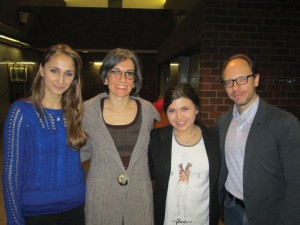Lauren Chardukian
Staff Writer

2015-one hundred years since the 1915 Armenian Genocide. Filmmaking began taking roots in society about that same time and since the rise in popularity of film, it has become one of the greatest media for expressing emotions and feelings, in ways that books and traditional artwork are unable to do.
Dr. Myrna Douzjian, the Kazan Visiting Professor in Armenian Studies for the Spring 2015, presented her second public lecture of the semester, “Atom Egoyan’s Ararat: Traumatic Histories and Transnational Identities” on Thursday, March 19 and her third and final lecture, on Wednesday, April 8, was about “Reinventing the Genocide Documentary: Solemnity.”
Dr. Douzjian began her March 19 lecture discussing the basic plot of the movie Ararat. The film is about the making of a film that features “in Hollywood-esque fashion, the Armenians’ acts of self-defense in Van in 1915.” She noted that the filmmaker, Atom Egoyan, critiques the film within a film that is being made by director Edward Saroyan in the Egoyan film.
Though both films have their own story, Dr. Douzjian noted that there are at least fourteen more interwoven stories within the main film. She presented some of the main scenes and plot points that were critiqued with the film, but the largest issue stemmed from the fact that many believed Egoyan did not represent “the Armenian Genocide as the clear cut historical fact that it is.”
For some, the film was confusing because of the unrealistic portrayal of the Armenian Genocide. In Dr. Douzjian’s opinion, the actual function of the film is to show “methods of coping with it [the Genocide] and its denial in the present day.” She also discussed that even though the bulk of the Armenian Diaspora came about because of the Genocide, they experience the world differently because they themselves did not experience the Genocide. Each of Egoyan’s characters experience what the Genocide means and its repercussions.
It was easy to see Dr. Douzjian’s passion for her subject in her final lecture of the semester. The presentation began with the introduction of Hrayr Anmahouni Eulmessekian, who together with Anahid Kassabian, created their interactive art piece called Solemnity. The piece consists of an iconic image of the Armenian Genocide, that is projected on a wall, but it is also dynamic and associated with sound.
Dr. Douzjian compared this piece to the traditional form of documentaries, which she considers a post-modernist approach. Once Dr. Douzjian presented the piece and her thoughts, she invited Eulmessekian to answer some of her questions and to give his comments. They discussed the physical work of assembling the piece and what was involved during the process. Because there was not a certain order or synchronism to the image being projected and to the audio being played, each day there was a different combination of sound and picture. Eulmessekian spoke about how using a well-known photo in his piece gave each person shown an identity that they once had.
Though the presentation concluded Dr. Douzjian’s lecture series, it provided the environment for those that attended to prepare themselves for an important and memorable 100th Anniversary of the Armenian Genocide.
represent “the Armenian Genocide as the clear cut historical fact that it is.”
For some, the film was confusing because of the unrealistic portrayal of the Armenian Genocide. In Dr. Douzjian’s opinion, the actual function of the film is to show “methods of coping with it [the Genocide] and its denial in the present day.” She also discussed that even though the bulk of the Armenian Diaspora came about because of the Genocide, they experience the world differently because they themselves did not experience the Genocide. Each of Egoyan’s characters experience what the Genocide means and its repercussions.
It was easy to see Dr. Douzjian’s passion for her subject in her final lecture of the semester. The presentation began with the introduction of Hrayr Anmahouni Eulmessekian, who together with Anahid Kassabian, created their interactive art piece called Solemnity. The piece consists of an iconic image of the Armenian Genocide, that is projected on a wall, but it is also dynamic and associated with sound.
Dr. Douzjian compared this piece to the traditional form of documentaries, which she considers a post-modernist approach. Once Dr. Douzjian presented the piece and her thoughts, she invited Eulmessekian to answer some of her questions and to give his comments. They discussed the physical work of assembling the piece and what was involved during the process. Because there was not a certain order or synchronism to the image being projected and to the audio being played, each day there was a different combination of sound and picture. Eulmessekian spoke about how using a well-known photo in his piece gave each person shown an identity that they once had.
Though the presentation concluded Dr. Douzjian’s lecture series, it provided the environment for those that attended to prepare themselves for an important and memorable 100th Anniversary of the Armenian Genocide.
 Hye Sharzhoom Armenian Action
Hye Sharzhoom Armenian Action